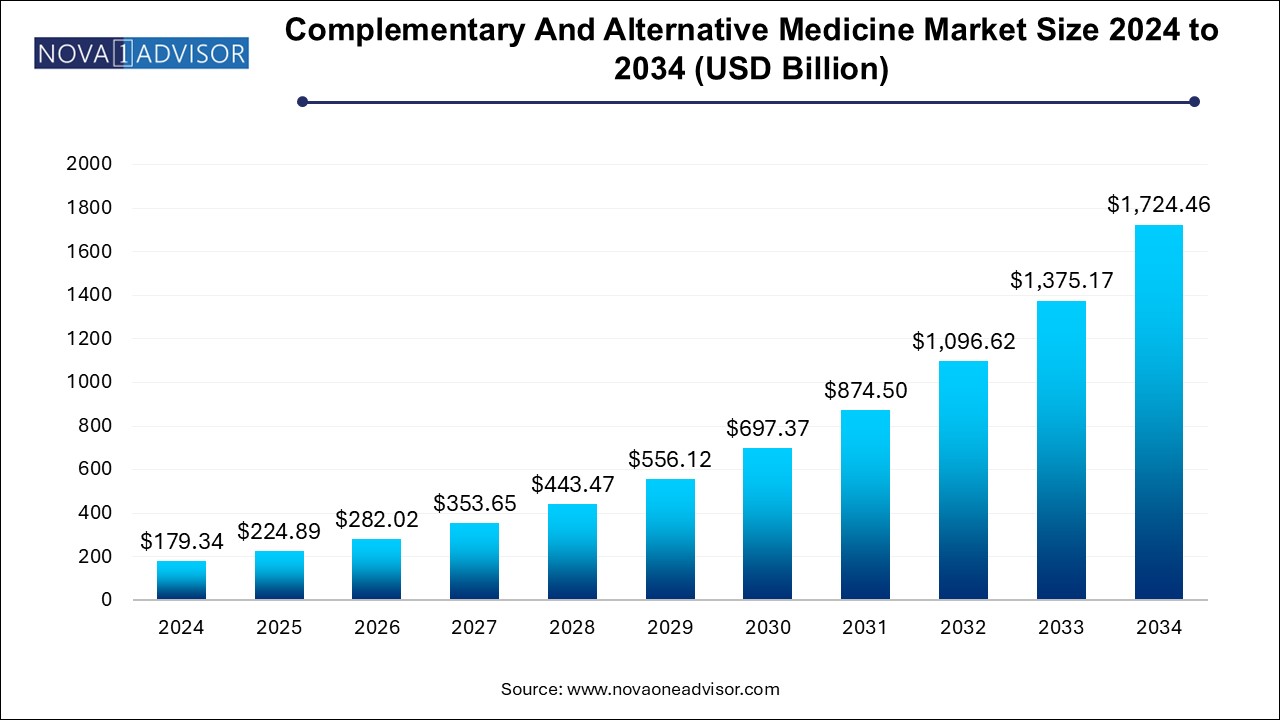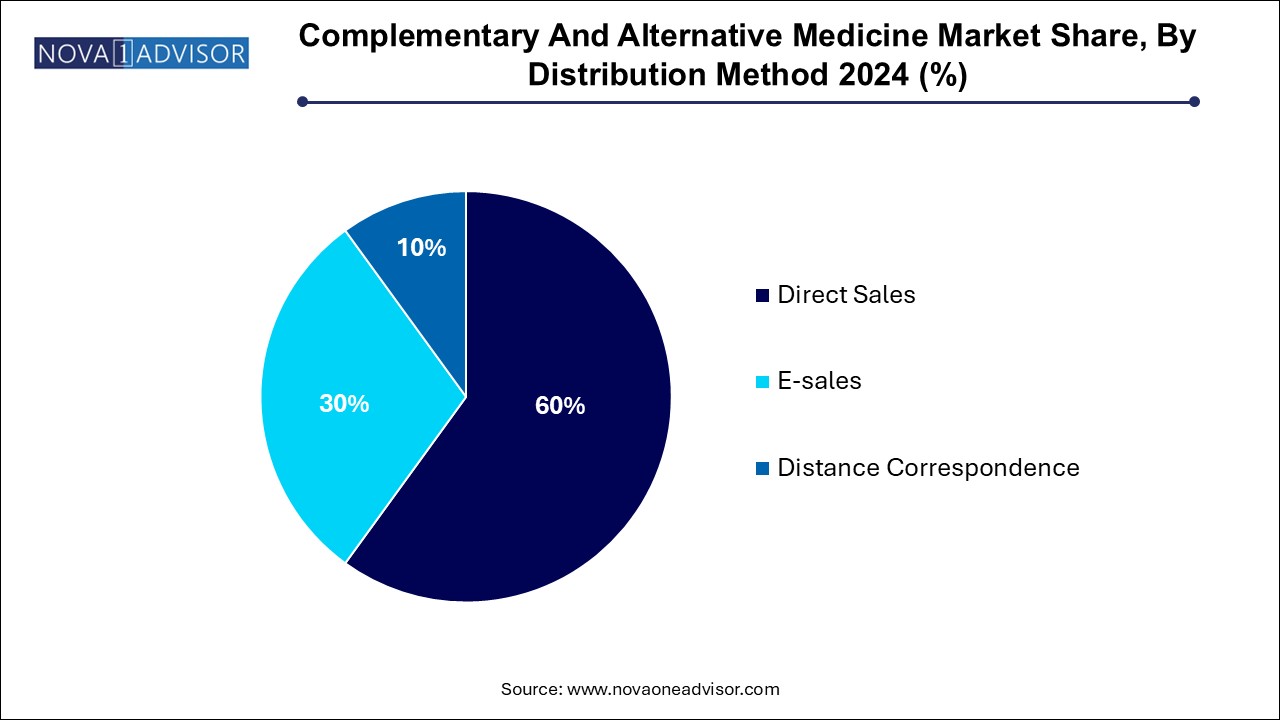Complementary And Alternative Medicine Market Size and Trends
The complementary and alternative medicine market size was exhibited at USD 179.34 billion in 2024 and is projected to hit around USD 1,724.46 billion by 2034, growing at a CAGR of 25.4x% during the forecast period 2024 to 2034.

Complementary And Alternative Medicine Market Key Takeaways:
- In 2024, traditional alternative medicine dominated the complementary and alternative medicine market with a share of 34.02%.
- The mind healing segment is anticipated to witness the fastest growth rate between 2024 and 2034.
- In 2024, direct sales had the largest revenue size.
- E-sales distribution channel is expected to grow at a fastest CAGR over the forecast period.
- Europe held the largest share of 33.98% in 2024 of the complementary & alternative medicine market.
- Asia Pacific is expected to grow at a lucrative rate during the forecasted period.
Market Overview
The Complementary and Alternative Medicine (CAM) market has emerged as a major force within the global healthcare sector, reflecting a growing demand for holistic, personalized, and preventive health approaches. CAM encompasses a broad array of practices and therapies that lie outside conventional Western medicine, including herbal remedies, mind-body interventions, body-based methods, and energy healing.
The rising prevalence of chronic diseases, escalating healthcare costs, growing consumer awareness about natural and non-invasive therapies, and an increasing emphasis on wellness and preventive healthcare are fueling global CAM adoption. Patients are seeking integrative approaches that align with lifestyle values, cultural preferences, and concerns about the side effects of pharmaceutical drugs.
In recent years, medical professionals and policymakers have also become more receptive to incorporating validated CAM therapies into mainstream treatment protocols, particularly for pain management, mental health, oncology support, and chronic disease management. Additionally, advancements in scientific research, growing evidence bases, and greater regulatory recognition are boosting the credibility of many CAM practices.
The COVID-19 pandemic further accelerated interest in CAM therapies aimed at boosting immunity, reducing stress, and enhancing overall well-being, thus reinforcing the sector’s resilience and growth potential.
Major Trends in the Market
-
Integration of CAM with Conventional Healthcare: Growing collaboration between CAM practitioners and allopathic medicine providers.
-
Increased Research and Evidence-based Validation: Expanding clinical trials assessing the efficacy and safety of CAM modalities.
-
Digital Transformation of CAM Delivery: Surge in online consultations, virtual yoga classes, e-sales of herbal supplements, and teletherapy sessions.
-
Focus on Preventive and Holistic Wellness: Shift from disease treatment to preventive care using CAM therapies.
-
Popularity of Traditional Systems: Rising global interest in Ayurveda, Traditional Chinese Medicine (TCM), and naturopathy.
-
Regulatory Recognition and Standardization Efforts: Emerging frameworks aimed at regulating CAM products and practitioner qualifications.
-
Rise of Mind-body Therapies: Explosive growth in practices like meditation, yoga, and mindfulness to address mental health issues.
-
Personalized and Customized Therapies: Tailoring CAM treatments based on individual patient profiles, including genetic and lifestyle factors.
Report Scope of Complementary And Alternative Medicine Market
| Report Coverage |
Details |
| Market Size in 2025 |
USD 224.89 Billion |
| Market Size by 2034 |
USD 1,724.46 Billion |
| Growth Rate From 2024 to 2034 |
CAGR of 25.4% |
| Base Year |
2024 |
| Forecast Period |
2024-2034 |
| Segments Covered |
Intervention, Distribution Method, Region |
| Market Analysis (Terms Used) |
Value (US$ Million/Billion) or (Volume/Units) |
| Regional Covered |
North America; Europe; Asia Pacific; Latin America; MEA |
| Key Companies Profiled |
Columbia Nutritional; Nordic Nutraceuticals; Ramamani Iyengar Memorial Yoga Institute; The Healing Company Ltd.; John Schumacher Unity Woods Yoga Centre; Sheng Chang Pharmaceutical Company; Pure encapsulations, LLC.; Herb Pharm; AYUSH Ayurvedic Pte Ltd. |
Key Market Driver: Rising Consumer Demand for Natural and Holistic Health Solutions
The foremost driver propelling the CAM market is the rising global consumer demand for natural, holistic, and preventive healthcare solutions.
Modern consumers are increasingly concerned about the side effects, overmedication, and impersonal nature of conventional healthcare. This has led to a strong preference for therapies that emphasize natural healing, mind-body balance, and individualized care. Herbal supplements, acupuncture, yoga, chiropractic care, aromatherapy, and meditation are gaining mass-market appeal not only among the elderly but also younger, health-conscious demographics.
Surging interest in mental well-being, fitness, anti-aging, and immune-boosting therapies particularly post-pandemic has amplified CAM adoption across socioeconomic groups. As awareness grows about the efficacy of many alternative practices, bolstered by media, influencers, and emerging scientific research, the CAM market continues to expand vigorously.
Key Market Restraint: Lack of Standardization and Regulatory Challenges
Despite its growth, the CAM market faces significant hurdles due to the lack of standardized regulation and scientific consensus regarding efficacy and safety.
Many CAM modalities operate outside formal healthcare regulatory frameworks, leading to variability in treatment quality, practitioner qualifications, and product composition. Herbal supplements, for example, often lack rigorous clinical testing and may exhibit batch-to-batch inconsistencies.
Inconsistent licensing, credentialing, and monitoring across countries create challenges for consumer trust, insurance coverage, and professional legitimacy. Concerns over unsubstantiated claims, interactions with conventional medications, and occasional adverse events also fuel skepticism among healthcare providers and segments of the patient population.
Strengthening research, professional standards, and global regulatory frameworks will be crucial to ensuring sustainable growth and broader integration of CAM into healthcare systems.
Key Market Opportunity: Integration with Mainstream Healthcare Systems
A major opportunity lies in the greater integration of complementary and alternative medicine with conventional healthcare systems.
Hospitals, rehabilitation centers, oncology units, and mental health clinics are increasingly incorporating CAM modalities like acupuncture, massage therapy, nutritional counseling, mindfulness programs, and chiropractic care into comprehensive treatment plans. This integrative approach improves patient satisfaction, enhances outcomes (especially for chronic pain, cancer support, and mental health), and often reduces healthcare costs.
Insurance coverage for select CAM services is expanding, particularly in regions like North America and parts of Europe, making therapies more accessible. Initiatives promoting evidence-based integrative medicine programs in academic medical centers offer lucrative opportunities for CAM providers and product manufacturers alike.
Complementary And Alternative Medicine Market By Intervention Insights
Traditional alternative medicine/botanicals dominate the intervention segment, capturing the largest share due to their long-standing cultural acceptance and growing global popularity. Systems such as Ayurveda, Traditional Chinese Medicine (TCM), and naturopathic medicine offer holistic frameworks combining herbal remedies, dietary therapy, and physical practices to promote health and treat disease.
Ayurveda and TCM have seen significant uptake outside their countries of origin, with increased use in North America and Europe. The availability of standardized herbal supplements, teas, tinctures, and functional foods derived from traditional medicine systems has expanded consumer access and trust.
Mind healing therapies are growing fastest, propelled by the escalating global mental health crisis and the increasing adoption of mindfulness, meditation, hypnotherapy, and neuro-linguistic programming (NLP). Practices like transcendental meditation, autosuggestion, and self-hypnosis are gaining popularity not just among individuals managing stress, anxiety, and depression but also among corporate wellness programs and educational institutions emphasizing emotional well-being.
Complementary And Alternative Medicine Market By Distribution Method Insights
Direct sales dominate the distribution method segment, driven by the personal nature of CAM services and therapies. Traditional practitioners such as acupuncturists, chiropractors, yoga instructors, and naturopaths typically deliver services directly through clinics, wellness centers, or retreats. Herbal remedies, aromatherapy products, and energy healing sessions are often sold through practitioner networks or specialized health shops.

E-sales are growing fastest, as the digital transformation of healthcare accelerates. Online platforms offer a wide range of CAM products including herbal supplements, yoga and meditation subscriptions, e-books, aromatherapy kits, and even remote energy healing sessions. The convenience, wide selection, and availability of customer reviews have driven explosive growth in CAM product e-commerce, with companies increasingly leveraging social media, mobile apps, and telemedicine portals to reach a broader audience.
Complementary And Alternative Medicine Market By Regional Insights
Asia Pacific holds the largest share of the CAM market, owing to its rich heritage of traditional medicine practices, strong cultural acceptance, and growing government initiatives supporting traditional therapies.
China, India, Japan, and South Korea dominate the regional landscape with deeply rooted systems such as Traditional Chinese Medicine, Ayurveda, Kampo (Japanese traditional medicine), and Korean Traditional Medicine. Government policies promoting traditional medicine research, education, and integration with modern healthcare systems strengthen market growth.
Moreover, the rising health consciousness among middle-class consumers, expanding medical tourism focused on CAM therapies, and growing exports of herbal and botanical products solidify Asia Pacific’s leadership in the global CAM market.
North America is the fastest-growing region, driven by escalating consumer demand for holistic wellness, the rising prevalence of chronic diseases, and greater insurance coverage for select CAM therapies.
The United States, in particular, has witnessed an explosion in the popularity of yoga, meditation, chiropractic care, acupuncture, and naturopathy. Integrative medicine programs are increasingly being incorporated into hospitals, cancer centers, and academic institutions.
The regulatory environment is also evolving, with bodies like the National Center for Complementary and Integrative Health (NCCIH) supporting research initiatives aimed at validating CAM efficacy and safety, further fueling North American market expansion.
Some of the prominent players in the complementary and alternative medicine market include:
- Columbia Nutritional
- Nordic Nutraceuticals
- Ramamani Iyengar Memorial Yoga Institute
- The Healing Company Ltd.
- John Schumacher Unity Woods Yoga Centre
- Sheng Chang Pharmaceutical Company
- Pure encapsulations, LLC.
- Herb Pharm
- AYUSH Ayurvedic Pte Ltd.
Complementary And Alternative Medicine Market Recent Developments
-
March 2025: Himalaya Wellness Company announced the launch of an expanded range of Ayurveda-based supplements in Europe and North America to meet growing demand for plant-based immunity and wellness products.
-
February 2025: The U.S. National Institutes of Health (NIH) announced new grants worth USD 50 million aimed at studying mind-body interventions, including mindfulness meditation and hypnotherapy, for chronic pain management.
-
January 2025: Chopra Global partnered with Amazon’s wellness division to offer virtual transcendental meditation programs and holistic wellness courses online.
-
December 2024: Traditional Chinese Medicine giant Tongrentang opened its first integrated TCM and modern diagnostic center in Dubai, catering to Middle Eastern medical tourism.
-
November 2024: Yoga Alliance reported a 25% rise in certified yoga instructors worldwide, driven by surging demand for online and in-person yoga classes post-pandemic.
Segments Covered in the Report
This report forecasts revenue growth at country levels and provides an analysis of the latest industry trends in each of the sub-segments from 2021 to 2034. For this study, Nova one advisor, Inc. has segmented the complementary and alternative medicine market
By Intervention
- Traditional Alternative Medicine/Botanicals
-
- Ayurveda
- Apitherapy
- Bach Flower Therapy
- Naturopathic Medicine
- Traditional Chinese Medicine
- Traditional Korean Medicine
- Traditional Japanese Medicine
- Traditional Mongolian Medicine
- Traditional Tibetan Medicine
- Zang Fu Theory
-
- Autosuggestion
- Hypnotherapy
- Neuro-linguistic Programming
- Self-hypnosis
- Spiritual Mind Treatment
- Transcendental Meditation
-
- Acupressure
- Acupuncture
- Alexander Technique
- Auriculotherapy
- Autogenic Training
- Chiropractic
- Cupping Therapy
- Kinesiology
- Osteomyology
- Osteopathy
- Pilates
- Qigong
- Reflexology
- Yoga
-
-
- Bio-magnetic Therapy
- Magnetic Resonance Therapy
-
- Radionics
- Reiki
- Therapeutic Touch
- Chakra Healing
- Sensory Healing
-
- Music therapy
- Sonopuncture
- Sound Therapy
By Distribution Method
- Direct Sales
- E-sales
- Distance Correspondence
By Regional
- North America
- Europe
- Asia Pacific
- Latin America
- Middle East and Africa (MEA)


